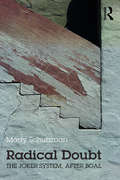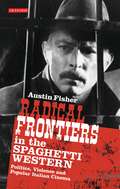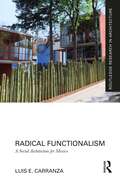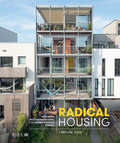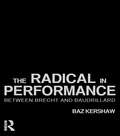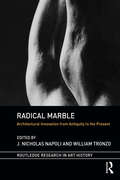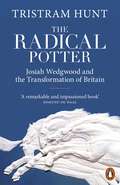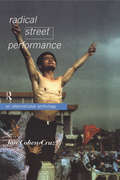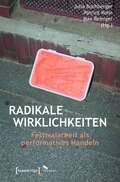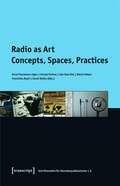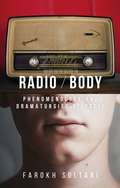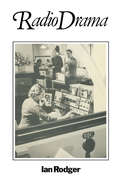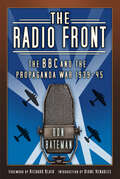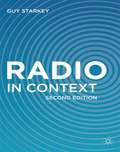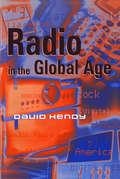- Table View
- List View
Radical Doubt: The Joker System, after Boal
by Mady SchutzmanRadical Doubt investigates ethical play across a spectrum of performances, on and off the stage. In witty, recursive, personal, and propulsive prose, Mady Schutzman elaborates on the Joker System, conceived by Augusto Boal, best known for Theatre of the Oppressed. The Joker System is a collaborative approach to representing social dilemmas through a rare fusion of destabilizing ambiguity and journalistic rigor. Schutzman models the Joker System while expanding well beyond the theatrical. In polyphonic compositions that perform their own philosophy, she uncovers illuminating links between calculus and conjuring, kōans and resistance, humor and witnessing, complexity theory and sorely needed new practices of living in our divisive times. These life practices rely upon crafty and circuitous strategies to deliver their subversive punch. Jok(er)ing matters, Schutzman insists. When communities fragment and identities fixate, enter the trickster! Sonja KuftinecTheatre Arts and Dance, University of Minnesota
Radical Frontiers in the Spaghetti Western: Politics, Violence and Popular Italian Cinema (International Library Of Visual Culture Ser.)
by Austin FisherEver more popular in the age of DVDs and online fandom, the Spaghetti Westerns of the 1960s have undergone a mainstream renaissance which has nevertheless left their relationship to the troubled politics of 1960s Italy unexamined. Radical Frontiers in the Spaghetti Western reappraises the genre in relation to the revolutionary New Left and the events of 1968 to uncover the complexities of a cinematic milieu often dismissed as formulaic. Establishing the backdrop of postwar Italy in which the Roman studio system actively blended Italian and American culture, Austin Fisher looks in detail at the works of Damiano Damiani, Sergio Sollima, Sergio Corbucci, Giulio Questi and Giulio Petroni, revealing how these directors reformatted the Hollywood Western to yield new resonance for militant constituencies and radical groups. Radical Frontiers in the Spaghetti Western identifies the main variants of these militant Westerns, which brazenly endorsed violent peasant insurrection in the 'Mexico' of the popular imagination, turning the camera on the hitherto heroic colonialists of the West and exposing the brutal mechanisms of a society infested with latent fascism. The ways in which the films' artistic failures reflectthe ideological confusions of the radical groups is examined and the genre's legacy is reappraised, as the revolutionary energy of Italy's New Left becomes subsumed amidst the conflicting agendas of New Hollywood, blaxploitation and the'grindhouse' revival of Tarantino, Rodriguez and Raimi.
Radical Functionalism: A Social Architecture for Mexico (Routledge Research in Architecture)
by Luis E. CarranzaRadical Functionalism: A Social Architecture for Mexico provides a complex and nuanced understanding of the functionalist architecture developed in Mexico during the 1930s. It carefully re-reads the central texts and projects of its main advocates to show how their theories responded to the socially and culturally charged Mexican context. These, such as architects Juan Legarreta, Juan O’Gorman, the Union of Socialist Architects, and Manuel Amábilis, were part of broader explorations to develop a modern, national architecture intended to address the needs of the Mexican working classes. Through their refunctioning of functionalism, these radical thinkers showed how architecture could stand at the precipice of Mexico's impending modernization and respond to its impending changes. The book examines their engagement and negotiation with foreign influences, issues of gender and class, and the separation between art and architecture. Functionalist practices are presented as contradictory and experimental, as challenging the role of architecture in the transformation of society, and as intimately linked to art and local culture in the development of new forms of architecture for Mexico, including the "vernacularization" of functionalism itself. Uniquely including translations of two manifesto-like texts by O’Gorman expressing the polemical nature of their investigations, Radical Functionalism: A Social Architecture for Mexico will be a useful reference for scholars, researchers and students interested in the history of architectural movements.
Radical Functionalism: A Social Architecture for Mexico (Routledge Research in Architecture)
by Luis E. CarranzaRadical Functionalism: A Social Architecture for Mexico provides a complex and nuanced understanding of the functionalist architecture developed in Mexico during the 1930s. It carefully re-reads the central texts and projects of its main advocates to show how their theories responded to the socially and culturally charged Mexican context. These, such as architects Juan Legarreta, Juan O’Gorman, the Union of Socialist Architects, and Manuel Amábilis, were part of broader explorations to develop a modern, national architecture intended to address the needs of the Mexican working classes. Through their refunctioning of functionalism, these radical thinkers showed how architecture could stand at the precipice of Mexico's impending modernization and respond to its impending changes. The book examines their engagement and negotiation with foreign influences, issues of gender and class, and the separation between art and architecture. Functionalist practices are presented as contradictory and experimental, as challenging the role of architecture in the transformation of society, and as intimately linked to art and local culture in the development of new forms of architecture for Mexico, including the "vernacularization" of functionalism itself. Uniquely including translations of two manifesto-like texts by O’Gorman expressing the polemical nature of their investigations, Radical Functionalism: A Social Architecture for Mexico will be a useful reference for scholars, researchers and students interested in the history of architectural movements.
Radical Housing: Designing multi-generational and co-living housing for all
by Caroline DoveRadical Housing explores the planning, technical, financial, health-based and social background for developing multi-generational homes and co-living. Abundantly illustrated with case studies and plans from projects across the UK and abroad, this book inform sand inspires the delivery of alternative approaches to affordable and flexible housing, and is an essential text for architecture practitioners, students, and community groups.
Radical Housing: Designing multi-generational and co-living housing for all
by Caroline DoveRadical Housing explores the planning, technical, financial, health-based and social background for developing multi-generational homes and co-living. Abundantly illustrated with case studies and plans from projects across the UK and abroad, this book inform sand inspires the delivery of alternative approaches to affordable and flexible housing, and is an essential text for architecture practitioners, students, and community groups.
The Radical in Performance: Between Brecht and Baudrillard
by Baz KershawThe Radical in Performance investigates the crisis in contemporary theatre, and celebrates the subversive in performance. It is the first full-length study to explore the link between a western theatre which, says Kershaw, is largely outdated and the blossoming of postmodern performance, much of which has a genuinely radical edge. In staying focused on the period between Brecht and Baudrillard, modernity and postmodernism, Baz Kershaw identifies crucial resources for the revitalisation of the radical across a wide spectrum of cultural practices. This is a timely, necessary and rigorous book. It will be a compelling read for anyone searching for a critical catalyst for new ways of viewing and practising cultural politics.
The Radical in Performance: Between Brecht and Baudrillard
by Baz KershawThe Radical in Performance investigates the crisis in contemporary theatre, and celebrates the subversive in performance. It is the first full-length study to explore the link between a western theatre which, says Kershaw, is largely outdated and the blossoming of postmodern performance, much of which has a genuinely radical edge. In staying focused on the period between Brecht and Baudrillard, modernity and postmodernism, Baz Kershaw identifies crucial resources for the revitalisation of the radical across a wide spectrum of cultural practices. This is a timely, necessary and rigorous book. It will be a compelling read for anyone searching for a critical catalyst for new ways of viewing and practising cultural politics.
Radical Marble: Architectural Innovation from Antiquity to the Present (Routledge Research in Art History)
Marble is one of the great veins through the architectural tradition and fundamental building block of the Mediterranean world, from the Parthenon of mid-fifth century Athens, which was constructed of pentelic marble, to Justinian’s Hagia Sophia in Constantinople and the Renaissance and Baroque basilica of St. Peter’s in the Vatican. Scholarship has done much in recent years to reveal the ways and means of marble. The use of colored marbles in Roman imperial architecture has recently been the subject of a major exhibition and the medieval traditions of marble working have been studied in the context of family genealogies and social networks. In addition, architectural historians have revealed the meanings evoked by marble revetted and paved surfaces, from Heavenly Jerusalem to frozen water. The present volume builds upon the body of recent and emerging research - from antiquity to the present day - to embrace a global focus and address the more unusual (or at least unexpected) uses, meanings, and aesthetic appeal of marble. It presents instances where the use of marble has revolutionized architectural practice, suggested new meaning for the built environment, or defined a new aesthetic - moments where this well-known material has been put to radical use.
Radical Marble: Architectural Innovation from Antiquity to the Present (Routledge Research in Art History)
Marble is one of the great veins through the architectural tradition and fundamental building block of the Mediterranean world, from the Parthenon of mid-fifth century Athens, which was constructed of pentelic marble, to Justinian’s Hagia Sophia in Constantinople and the Renaissance and Baroque basilica of St. Peter’s in the Vatican. Scholarship has done much in recent years to reveal the ways and means of marble. The use of colored marbles in Roman imperial architecture has recently been the subject of a major exhibition and the medieval traditions of marble working have been studied in the context of family genealogies and social networks. In addition, architectural historians have revealed the meanings evoked by marble revetted and paved surfaces, from Heavenly Jerusalem to frozen water. The present volume builds upon the body of recent and emerging research - from antiquity to the present day - to embrace a global focus and address the more unusual (or at least unexpected) uses, meanings, and aesthetic appeal of marble. It presents instances where the use of marble has revolutionized architectural practice, suggested new meaning for the built environment, or defined a new aesthetic - moments where this well-known material has been put to radical use.
The Radical Potter: Josiah Wedgwood and the Transformation of Britain
by Tristram HuntA spectacular new biography of the great designer, entrepreneur, abolitionist and beacon of the Industrial Revolution, from acclaimed historian and Director of the Victoria and Albert Museum, Tristram HuntJosiah Wedgwood, perhaps the greatest English potter who ever lived, epitomized the best of his age. From his kilns and workshops in Stoke-on-Trent, he revolutionized the production of ceramics in Georgian Britain by marrying technology with design, manufacturing efficiency and retail flair. He transformed the luxury markets not only of London, Liverpool, Bath and Dublin but of America and the world, and helping to usher in a mass consumer society. Tristram Hunt calls him 'the Steve Jobs of the eighteenth century'.But Wedgwood was radical in his mind and politics as well as in his designs. He campaigned for free trade and religious toleration, read pioneering papers to the Royal Society and was a member of the celebrated Lunar Society of Birmingham. Most significantly, he created the ceramic 'Emancipation Badge', depicting a slave in chains and inscribed 'Am I Not a Man and a Brother?' that became the symbol of the abolitionist movement.Tristram Hunt's hugely enjoyable new biography, strongly based on Wedgwood's notebooks, letters and the words of his contemporaries, brilliantly captures the energy and originality of Wedgwood and his extraordinary contribution to the transformation of eighteenth-century Britain.
Radical Street Performance: An International Anthology
by Jan Cohen-CruzRadical Street Performance is the first volume to collect together the fascinating array of writings by activists, directors, performers, critics, scholars and journalists who have documented street theatre around the world. More than thirty essays explore the myriad forms this most public of performances can take: * agit-prop * invisible theatre * demonstrations and rallies * direct action * puppetry * parades and pageants * performance art * guerrilla theatre * circuses These essays look at performaces in Europe, Africa, China, India and both the Americas. They describe engagement with issues as diverse as abortion, colonialism, the environment and homophobia, to name only a few. Introduced by editor Jan Cohen-Cruz, the essays are organized into thematic sections: Agitating; Witnessing; Involving; Imagining; and Popularizing. Radical Street Performance is an inspiring testimony to this international performance phenomenon, and an invaluable record of a form of theatre which continues to flourish in a televisual age.
Radical Street Performance: An International Anthology
by Jan Cohen-CruzRadical Street Performance is the first volume to collect together the fascinating array of writings by activists, directors, performers, critics, scholars and journalists who have documented street theatre around the world. More than thirty essays explore the myriad forms this most public of performances can take: * agit-prop * invisible theatre * demonstrations and rallies * direct action * puppetry * parades and pageants * performance art * guerrilla theatre * circuses These essays look at performaces in Europe, Africa, China, India and both the Americas. They describe engagement with issues as diverse as abortion, colonialism, the environment and homophobia, to name only a few. Introduced by editor Jan Cohen-Cruz, the essays are organized into thematic sections: Agitating; Witnessing; Involving; Imagining; and Popularizing. Radical Street Performance is an inspiring testimony to this international performance phenomenon, and an invaluable record of a form of theatre which continues to flourish in a televisual age.
Radikale Wirklichkeiten: Festivalarbeit als performatives Handeln (Theater #132)
by Julia Buchberger Patrick Kohn Max ReinigerIn den Theaterwissenschaften entwickelt sich das Forschungsfeld der »festivals studies« stetig weiter. Die Beiträger*innen des Bandes rücken erstmals die Arbeit an Festivals in den Fokus der Betrachtung und diskutieren sie hinsichtlich ihres performativen Potenzials in praxisorientierten Gesprächen, Essays und Aufsätzen. Diese bilden im Zusammenspiel einen Ansatz für eine radikale und ganzheitliche Betrachtung von Theaterfestivals und zeigen das Wechselspiel zwischen Ästhetik, Ökonomie und Kulturproduktion auf.
Radio (Modern Plays)
by Al SmithLying there, drifting up into those ancient lights was exactly like looking into the past. It is looking into the past. History, I think, is just a property of light.Charlie Fairbanks was born in the dead center of the United States at the dead center of the twentieth century.Americans are going to the Moon and Charlie's sure he'll be the first one there. But as he shines his spotlight on the Moon, so too does it illuminate the darker side to his nation's history.Radio is a story about memory, love and spaceships.
Radio (Modern Plays)
by Al SmithLying there, drifting up into those ancient lights was exactly like looking into the past. It is looking into the past. History, I think, is just a property of light.Charlie Fairbanks was born in the dead center of the United States at the dead center of the twentieth century.Americans are going to the Moon and Charlie's sure he'll be the first one there. But as he shines his spotlight on the Moon, so too does it illuminate the darker side to his nation's history.Radio is a story about memory, love and spaceships.
Radio as Art: Concepts, Spaces, Practices (Schriftenreihe für Künstlerpublikationen #8)
by Anne Thurmann-Jajes Ursula Frohne Jee-Hae Kim Maria Peters Franziska Rauh Sarah SchönewaldAcoustic signals, voice, sound, articulation, music and spatial networking are dispositifs of radiophonic transmission which have brought forth a great number of artistic practices. Up to and into the digital present radio has been and is employed and explored as an apparatus-based structure as well as an expanded model for performance and perception. This volume investigates a broad range of aesthetic experiments with the broadcasting technology of radio, and the use of radio as a means of disseminating artistic concepts. With exemplary case studies, its contributions link conceptual, recipient-response-related, and sociocultural issues to matters of relevance to radio art's mediation.
Radio / body: Phenomenology and dramaturgies of radio
by Farokh SoltaniThis study provides an in-depth exploration of the dramaturgical practices of radio drama and their underlying philosophical assumptions. By presenting an analytical model drawn from phenomenology, it challenges the current understanding of the medium, instead focusing on the bodily and aural aspects of radio drama, while offering a critique of the conventions of dramaturgical practice for neglecting these affective sonic aspects. Tracing these conventions through the history of the development of radio drama, it proposes that a more bodily, resonant mode of radio dramaturgy is best placed to meet the demands of the current era of digital production and distribution. The book also examines a number of approaches to creating a more embodied experience for the listener.
Radio / body: Phenomenology and dramaturgies of radio
by Farokh SoltaniThis study provides an in-depth exploration of the dramaturgical practices of radio drama and their underlying philosophical assumptions. By presenting an analytical model drawn from phenomenology, it challenges the current understanding of the medium, instead focusing on the bodily and aural aspects of radio drama, while offering a critique of the conventions of dramaturgical practice for neglecting these affective sonic aspects. Tracing these conventions through the history of the development of radio drama, it proposes that a more bodily, resonant mode of radio dramaturgy is best placed to meet the demands of the current era of digital production and distribution. The book also examines a number of approaches to creating a more embodied experience for the listener.
The Radio Front: The BBC and the Propaganda War 1939-45
by Ron BatemanWithin seventeen years of the first public broadcast in Britain, the nation again found itself at war. As the Second World War progressed, the BBC eventually realised the potential benefits of public radio and the service became vital in keeping an anxious public informed, upbeat and entertained behind the curtains of millions of blacked-out homes. The Radio Front examines just how the BBC reinvented itself and delivered its carefully controlled propaganda to listeners in the UK and throughout Nazi-occupied Europe. It also reveals the BBC’s often-strained relationships with the government, military and public as the organisation sought to influence opinion and safeguard public morale without damaging its growing reputation for objectivity and veracity.Using original source material, historian and author Ron Bateman tracks the BBC’s growth during the Second World War from its unorganised and humble beginnings to the development of a huge overseas and European operation, and also evaluates the importance of iconic broadcasts from the likes of J.B. Priestley, Vera Lynn and Tommy Handley.
Radio in Context (Second Edition)
by Guy StarkeyThis revised and updated new edition of a core text for radio studies offers students a critical introduction to the field; it blends theory and practical guidance, covers the most important radio genres, and addresses key changes in the landscape of radio production since publication of the first edition in 2004.
Radio in Context (Second Edition) (PDF)
by Guy StarkeyThis revised and updated new edition of a core text for radio studies offers students a critical introduction to the field; it blends theory and practical guidance, covers the most important radio genres, and addresses key changes in the landscape of radio production since publication of the first edition in 2004.
Radio in the Global Age
by David HendyRadio in the Global Age offers a fresh, up-to-date, and wide-ranging introduction to the role of radio in contemporary society. It places radio, for the first time, in a global context, and pays special attention to the impact of the Internet, digitalization and globalization on the political-economy of radio. It also provides a new emphasis on the links between music and radio, the impact of formatting, and the broader cultural roles the medium plays in constructing identities and nurturing musical tastes. Individual chapters explore the changing structures of the radio industry, the way programmes are produced, the act of listening and the construction of audiences, the different meanings attached to programmes, and the cultural impact of radio across the globe. David Hendy portrays a medium of extraordinary contradictions: a cheap and accessible means of communication, but also one increasingly dominated by rigid formats and multinational companies; a highly 'intimate' medium, but one capable of building large communities of listeners scattered across huge spaces; a force for nourishing regional identity, but also a pervasive broadcaster of globalized music products; a 'stimulus to the imagination', but a purveyor of the banal and of the routine. Drawing on recent research from as far afield as Africa, Australasia and Latin America, as well as from the UK and US, the book aims to explore and to explain these paradoxes - and, in the process, to offer an imaginative reworking of Marshall McLuhan's famous dictum that radio is one of the world's 'hot' media. Radio in the Global Age is an invaluable text for undergraduates and researchers in media studies, communication studies, journalism, cultural studies, and musicology. It will also be of interest to practitioners and policy-makers in the radio industry.
Radio in the Global Age
by David HendyRadio in the Global Age offers a fresh, up-to-date, and wide-ranging introduction to the role of radio in contemporary society. It places radio, for the first time, in a global context, and pays special attention to the impact of the Internet, digitalization and globalization on the political-economy of radio. It also provides a new emphasis on the links between music and radio, the impact of formatting, and the broader cultural roles the medium plays in constructing identities and nurturing musical tastes. Individual chapters explore the changing structures of the radio industry, the way programmes are produced, the act of listening and the construction of audiences, the different meanings attached to programmes, and the cultural impact of radio across the globe. David Hendy portrays a medium of extraordinary contradictions: a cheap and accessible means of communication, but also one increasingly dominated by rigid formats and multinational companies; a highly 'intimate' medium, but one capable of building large communities of listeners scattered across huge spaces; a force for nourishing regional identity, but also a pervasive broadcaster of globalized music products; a 'stimulus to the imagination', but a purveyor of the banal and of the routine. Drawing on recent research from as far afield as Africa, Australasia and Latin America, as well as from the UK and US, the book aims to explore and to explain these paradoxes - and, in the process, to offer an imaginative reworking of Marshall McLuhan's famous dictum that radio is one of the world's 'hot' media. Radio in the Global Age is an invaluable text for undergraduates and researchers in media studies, communication studies, journalism, cultural studies, and musicology. It will also be of interest to practitioners and policy-makers in the radio industry.
